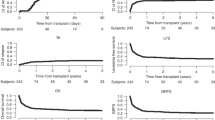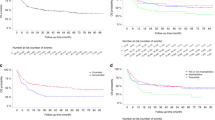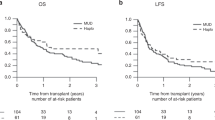Abstract
For adults with high-risk or recurrent ALL who lack a suitable sibling donor, the decision between autologous (Auto) and unrelated donor (URD) hematopoietic stem cell transplantation (HSCT) is difficult due to variable risks of relapse and treatment-related mortality (TRM). We analysed data from two transplant registries to determine outcomes between Auto and URD HSCT for 260 adult ALL patients in first (CR1) or second (CR2) CR. All patients received a myeloablative conditioning regimen. The median follow-up was 77 (range 12–170) months. TRM at 1 year post transplant was significantly higher with URD HSCT; however, there were minimal differences in TRM according to disease status. Relapse was higher with Auto HSCT and was increased in patients transplanted in CR2. Five-year leukemia-free (37 vs 39%) and overall survival (OS) rates (38 vs 39%) were similar for Auto HSCT vs URD HSCT in CR1. There were trends favoring URD HSCT in CR2. The long-term follow-up in this analysis demonstrated that either Auto or URD HSCT could result in long-term leukaemia-free survival and OS for adult ALL patients. The optimal time (CR1 vs CR2) and technique to perform HSCT remains an important clinical question for adult ALL patients.
This is a preview of subscription content, access via your institution
Access options
Subscribe to this journal
Receive 12 print issues and online access
$259.00 per year
only $21.58 per issue
Buy this article
- Purchase on Springer Link
- Instant access to full article PDF
Prices may be subject to local taxes which are calculated during checkout




Similar content being viewed by others
References
Jabbour EJ, Faderl S, Kantarjian HM . Adult acute lymphoblastic leukemia. Mayo Clin Proc 2005; 80: 1517–1527.
Rowe JM, Buck G, Burnett AK, Chopra R, Wiernik PH, Richards SM, et al., ECOG; MRC/NCRI Adult Leukemia Working Party. Induction therapy for adults with acute lymphoblastic leukemia: results of more than 1500 patients from the international ALL trial–MRC UKALL XII/ECOG E2993. Blood 2005; 106: 3760–3767.
Larson RA . Recent clinical trials in acute lymphocytic leukemia by the Cancer and Leukemia Group B. Hematol Oncol Clin North Am 2000; 14: 1367–1379.
Chao NJ, Forman SJ, Schmidt GM, Snyder DS, Amylon MD, Konrad PN et al. Allogeneic bone marrow transplantation for high-risk acute lymphoblastic leukemia during first complete remission. Blood 1991; 78: 1923–1927.
Oh H, Gale RP, Zhang MJ, Ino T, Murakami H, Ohno R et al. Chemotherapy vs HLA-identical sibling bone marrow transplants for adults with acute lymphoblastic leukemia in first remission. Bone Marrow Transplant 1998; 22: 253–257.
Zhang M-J, Hoelzer D, Horowitz M, Gale RP, Messerer D, Klein JP et al., for the Acute Lymphoblastic Leukemia Working Committee. Long-term follow-up of adults with acute lymphoblastic leukemia in first remission treated with chemotherapy or bone marrow transplantation. Ann Int Med 1995; 123: 428–431.
Hunault M, Harousseau JL, Delain M, Truchan-Graczyk M, Cahn JY, Witz F, et al., GOELAMS (Groupe Ouest-Est des Leucemies Airgues et Maladies du Sang) Group. Better outcome of adult acute lymphoblastic leukemia after early genoidentical allogeneic bone marrow transplantation (BMT) than after late high-dose therapy and autologous BMT: a GOELAMS trial. Blood 2004; 104: 3028–3037.
Kiehl MG, Kraut L, Schwerdtfeger R, Hertenstein B, Remberger M, Kroeger N et al. Outcome of allogeneic hematopoietic stem-cell transplantation in adult patients with acute lymphoblastic leukemia: no difference in related compared with unrelated transplant in first complete remission. J Clin Oncol 2004; 22: 2816–2825.
Thomas X, Boiron JM, Huguet F, Dombret H, Bradstock K, Vey N et al. Outcome of treatment in adults with acute lymphoblastic leukemia: analysis of the LALA-94 trial. J Clin Oncol 2004; 22: 4075–4086.
Wingard JR, Piantadosi S, Santos GW, Saral R, Vriesendorp HM, Yeager AM et al. Allogeneic bone marrow transplantation for patients with high-risk acute lymphoblastic leukemia. J Clin Oncol 1990; 8: 820–830.
Weisdorf DJ, Woods WG, Nesbit Jr ME, Uckun F, Dusenbery K, Kim T et al. Allogeneic bone marrow transplantation for acute lymphoblastic leukaemia: risk factors and clinical outcome. Br J Haematol 1994; 86: 62–69.
Giona F, Annino L, Rondelli R, Arcese W, Meloni G, Testi AM et al. Treatment of adults with acute lymphoblastic leukaemia in first bone marrow relapse: results of the ALL R-87 protocol. Br J Haematol 1997; 97: 896–903.
Camera A, Annino L, Chiurazzi F, Fazi P, Cascavilla N, Fabbiano F et al. GIMEMA ALL—Rescue 97: a salvage strategy for primary refractory or relapsed adult acute lymphoblastic leukemia. Haematologica 2004; 89: 145–153.
Simonsson B, Burnett AK, Prentice HG, Hann IH, Brenner MK, Gibson B et al. Autologous bone marrow transplantation with monoclonal antibody purged marrow for high risk acute lymphoblastic leukemia. Leukemia 1989; 3: 631–636.
Schiller G, Feig SA, Territo M, Wolin M, Lill M, Belin T et al. Treatment of advanced acute leukaemia with allogeneic bone marrow transplantation from unrelated donors. Br J Haematol 1994; 88: 72–78.
Cornetta K, Laughlin M, Carter S, Wall D, Weinthal J, Delaney C et al. Umbilical cord blood transplantation in adults: results of the prospective Cord Blood Transplantation (COBLT). Biol Blood Marrow Transplant 2005; 11: 149–160.
Busca A, Anasetti C, Anderson G, Appelbaum FR, Buckner CD, Doney K et al. Unrelated donor or autologous marrow transplantation for treatment of acute leukemia. Blood 1994; 83: 3077–3084.
Ringden O, Labopin M, Gluckman E, Hows JM, Bradley BA, Kolb HJ et al. Donor search or autografting in patients with acute leukaemia who lack an HLA-identical sibling? A matched-pair analysis. Acute Leukaemia Working Party of the European Cooperative Group for Blood and Marrow Transplantation (EBMT) and the International Marrow Unrelated Search and Transplant (IMUST) Study. Bone Marrow Transplant 1997; 19: 963–968.
Weisdorf DJ, Billett AL, Hannan P, Ritz J, Sallan SE, Steinbuch M et al. Autologous versus unrelated donor allogeneic marrow transplantation for acute lymphoblastic leukemia. Blood 1997; 90: 2962–2968.
Barker JN, Krepski TP, DeFor TE, Davies SM, Wagner JE, Weisdorf DJ . Searching for unrelated donor hematopoietic stem cells: availability and speed of umbilical cord blood versus bone marrow. Biol Blood Marrow Transplant 2002; 8: 257–260.
Cornelissen JJ, Carston M, Kollman C, King R, Dekker AW, Lowenberg B et al. Unrelated marrow transplantation for adult patients with poor-risk acute lymphoblastic leukemia: strong graft-versus-leukemia effect and risk factors determining outcome. Blood 2001; 97: 1572–1577.
Gale RP, Park RE, Dubois RW, Herzig GP, Hocking WG, Horowitz MM et al. Delphi-panel analysis of appropriateness of high-dose therapy and bone marrow transplants in adults with acute lymphoblastic leukemia in first remission. Leuk Res 1998; 22: 973–981.
Weisdorf D, Bishop M, Dharan B, Bolwell B, Cahn JY, Cairo M et al. Autologous versus allogeneic unrelated donor transplantation for acute lymphoblastic leukemia: comparative toxicity and outcomes. Biol Blood Marrow Transplant 2002; 8: 213–220.
Marks DI, Aversa F, Lazarus HM . Alternative donor transplants for adult acute lymphoblastic leukaemia: a comparison of the three major options. Bone Marrow Transplant 2006; 38: 467–475.
Ribera JM, Oriol A, Bethencourt C, Parody R, Hernandez-Rivas JM, Moreno MJ et al., PETHEMA Group, Spain. Comparison of intensive chemotherapy, allogeneic or autologous stem cell transplantation as post-remission treatment for adult patients with high-risk acute lymphoblastic leukemia. Results of the PETHEMA ALL-93 trial. Haematologica 2005; 90: 1346–1356.
Dhedin N, Dombret H, Thomas X, Lheritier V, Boiron JM, Rigal-Huguet F et al. Autologous stem cell transplantation in adults with acute lymphoblastic leukemia in first complete remission: analysis of the LALA-85, -87 and -94 trials. Leukemia 2006; 20: 336–344.
Lazarus HM, Pérez WS, Klein JP, Kollman C, Bate-Boyle B, Bredeson CN et al. Autotransplantation versus HLA-matched unrelated donor transplantation for acute myeloid leukaemia: a retrospective analysis from the Center for International Blood and Marrow Transplant Research. Br J Haematol 2006; 132: 755–769.
Thomas DA, Kantarjian H, Smith TL, Koller C, Cortes J, O'Brien S et al. Primary refractory and relapsed adult acute lymphoblastic leukemia: characteristics, treatment results, and prognosis with salvage therapy. Cancer 1999; 86: 1216–1230.
Dodson KL, Coppo PA, Confer DL . The National Marrow Donor Program: improving access to hematopoietic stem cell transplantation. Clin Transpl 1999, 121–127.
Noreen HJ, Yu N, Setterholm M, Ohashi M, Baisch J, Endres R et al. Validation of DNA-based HLA-A and HLA-B testing of volunteers for a bone marrow registry through parallel testing with serology. Tissue Antigens 2001; 57: 221–229.
Anasetti C, Petersdorf EW, Martin PJ, Woolfrey A, Hansen JA . Trends in transplantation of hematopoietic stem cells from unrelated donors. Curr Opin Hematol 2001; 8: 337–341.
Flomenberg N, Baxter-Lowe LA, Confer D, Fernandez-Vina M, Filipovich A, Horowitz M et al. Impact of HLA class I and class II high-resolution matching on outcomes of unrelated donor bone marrow transplantation: HLA-C mismatching is associated with a strong adverse effect on transplantation outcome. Blood 2004; 104: 1923–1930.
Lazarus HM, Vogelsang GB, Rowe JM . Prevention and treatment of acute graft-versus-host disease: the old and the new. A report from the Eastern Cooperative Oncology Group (ECOG). Bone Marrow Transplant 1997; 19: 577–600.
Sullivan KM, Dykewicz CA, Longworth DL, Boeckh M, Baden LR, Rubin RH et al. Preventing opportunistic infections after hematopoietic stem cell transplantation: the centers for disease control and prevention, Infectious Diseases Society of America, and American Society for Blood and Marrow Transplantation practice guidelines and beyond. Hematology Am Soc Hematol Educ Program 2001, 392–421.
Chakraverty R, Peggs K, Chopra R, Milligan DW, Kottaridis PD, Verfuerth S et al. Limiting transplantation-related mortality following unrelated donor stem cell transplantation by using a nonmyeloablative conditioning regimen. Blood 2002; 99: 1071–1078.
Maris MB, Niederwieser D, Sandmaier BM, Storer B, Stuart M, Maloney D et al. HLA-matched unrelated donor hematopoietic cell transplantation after nonmyeloablative conditioning for patients with hematologic malignancies. Blood 2003; 102: 2021–2030.
Martino R, Giralt S, Caballero MD, Mackinnon S, Corradini P, Fernandez-Avilés F et al. Allogeneic hematopoietic stem cell transplantation with reduced-intensity conditioning in acute lymphoblastic leukemia: a feasibility study. Haematologica 2003; 88: 555–560.
Powles R, Sirohi B, Treleaven J, Kulkarni S, Tait D, Singhal S et al. The role of posttransplantation maintenance chemotherapy in improving the outcome of autotransplantation in adult acute lymphoblastic leukemia. Blood 2002; 100: 1641–1647.
Shin HJ, Chung JS, Cho GJ . Imatinib interim therapy between chemotherapeutic cycles and in vivo purging prior to autologous stem cell transplantation, followed by maintenance therapy is a feasible treatment strategy in Philadelphia chromosome-positive acute lymphoblastic leukemia. Bone Marrow Transplant 2005; 36: 917–918.
Acknowledgements
The CIBMTR is supported by Public Health Service Grant U24-CA76518 from the National Cancer Institute, the National Institute of Allergy and Infectious Diseases, and the National Heart, Lung and Blood Institute; Office of Naval Research; Health Services Research Administration (DHHS); and grants from AABB; Abbott Laboratories; Aetna; AIG Medical Excess; American Red Cross; Amgen Inc.; Anonymous donation to the Medical College of Wisconsin; AnorMED Inc.; Astellas Pharma US Inc.; Berlex Laboratories Inc.; Biogen IDEC Inc.; Blue Cross and Blue Shield Association; BRT Laboratories Inc.; Celgene Corp.; Cell Therapeutics Inc.; CelMed Biosciences; Cubist Pharmaceuticals; Dynal Biotech, LLC; Edwards Lifesciences RMI; Endo Pharmaceuticals Inc.; Enzon Pharmaceuticals Inc.; ESP Pharma; Gambro BCT Inc.; Genzyme Corporation; GlaxoSmithKline Inc.; Histogenetics Inc.; Human Genome Sciences; International Waldenstrom Macroglobulinemia Foundation; Kirin Brewery Company; Ligand Pharmaceuticals Inc.; Merck & Company; Millennium Pharmaceuticals; Miller Pharmacal Group; Milliman USA Inc.; Miltenyi Biotec; National Center for Biotechnology Information; National Leukemia Research Association; National Marrow Donor Program; Nektar Therapeutics; NeoRx Corporation; Novartis Pharmaceuticals Inc.; Novo Nordisk Pharmaceuticals; Ortho Biotech Inc.; Osiris Therapeutics Inc.; Pall Medical; Pfizer Inc.; Pharmion Corp.; Protein Design Labs Inc.; QOL Medical; Roche Laboratories; StemCyte Inc.; Stemco Biomedical; StemSoft Software Inc.; SuperGen Inc.; Sysmex; The Marrow Foundation; THERAKOS, a Johnson & Johnson Co.; University of Colorado Cord Blood Bank; Valeant Pharmaceuticals; ViaCell Inc.; ViraCor Laboratories; WB Saunders Mosby Churchill; Wellpoint Inc.; and Zelos Therapeutics Inc. The views expressed in this article do not reflect the official policy or position of the National Cancer Institute, the Department of the Navy, the Department of Defense, or the Government of the United States.
This research has been supported by funding from the National Marrow Donor Program, the Health Resources and Services administration No. 240-97-0036 and the Office of Naval Research N00014-96-2-0016 and N00014-99-2-0006 to the National Marrow Donor Program.
Author information
Authors and Affiliations
Corresponding author
Rights and permissions
About this article
Cite this article
Bishop, M., Logan, B., Gandham, S. et al. Long-term outcomes of adults with acute lymphoblastic leukemia after autologous or unrelated donor bone marrow transplantation: a comparative analysis by the National Marrow Donor Program and Center for International Blood and Marrow Transplant Research. Bone Marrow Transplant 41, 635–642 (2008). https://doi.org/10.1038/sj.bmt.1705952
Received:
Revised:
Accepted:
Published:
Issue Date:
DOI: https://doi.org/10.1038/sj.bmt.1705952
Keywords
This article is cited by
-
Prognostic factors for survival after allogeneic transplantation in acute lymphoblastic leukemia
Bone Marrow Transplantation (2021)
-
Recent Advances in the Management of Acute Lymphoblastic Leukaemia
Current Treatment Options in Oncology (2020)
-
Allogeneic hematopoietic stem cell transplantation in adult acute lymphoblastic leukemia: potential benefit of medium-dose etoposide conditioning
Experimental Hematology & Oncology (2015)
-
Reduced-intensity vs myeloablative conditioning allogeneic hematopoietic SCT for patients aged over 45 years with ALL in remission: a study from the Adult ALL Working Group of the Japan Society for Hematopoietic Cell Transplantation (JSHCT)
Bone Marrow Transplantation (2013)
-
Acute lymphoblastic leukemia in first complete remission: temporal trend of outcomes in studies comparing allogeneic transplant with autologous transplant or chemotherapy
Annals of Hematology (2013)



